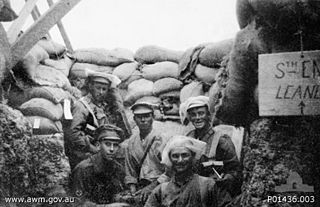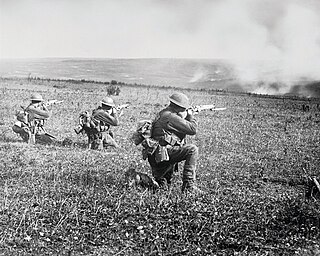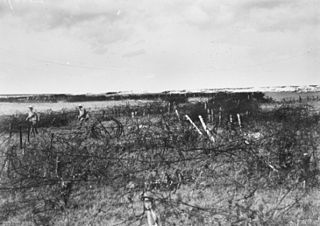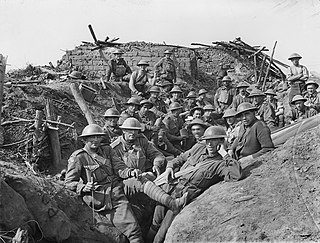The 5th Battalion was an infantry battalion of the Australian Army. Raised in Victoria as part of the First Australian Imperial Force for service during World War I, the battalion formed part of the 2nd Brigade, attached to the 1st Division. It participated in the landing at Anzac Cove on 25 April 1915, coming ashore in the second wave, before taking part in the fighting at Krithia and then at Lone Pine. In December 1915, the battalion was withdrawn from the peninsula and returned to Egypt where it was involved in defending the Suez Canal until being transferred to the Western Front in France in early 1916. After that, over the course of the next two and a half years the 5th Battalion was rotated in and out of the front line and took part in a number of significant battles including at Pozieres, Ypres, Amiens and the Hindenburg Line. Following the end of the war, the battalion was disbanded and its personnel returned to Australia. The battalion was re-raised during the inter-war years as a part-time unit and was later mobilised during World War II, but did not serve overseas. During the post war period, the battalion has existed at various times before being subsumed into the 5th/6th Battalion, Royal Victoria Regiment.

The 12th Battalion was an infantry battalion originally raised for the First Australian Imperial Force during the First World War. The battalion was recruited from Tasmania, South Australia and Western Australia and formed part of the 3rd Brigade, 1st Division. It served throughout the war, firstly during the Gallipoli Campaign and then on the Western Front. During the interwar years, the 12th Battalion was re-raised as a part-time military unit and during the Second World War undertook garrison duties in Australia, but did not see combat. Today its lineage is perpetuated by the 12th/40th Battalion, Royal Tasmania Regiment, a unit which continues to serve in the Australian Army Reserve.

The 13th Battalion was an infantry battalion of the Australian Army. Originally raised for the 1st Australian Imperial Force during the First World War, it was formed just six weeks after the start of the war. Along with the 14th, 15th and 16th Battalions which were recruited from New South Wales, it formed the 4th Brigade. The battalion saw service initially at Gallipoli before being transferred to France in 1916. For the next two years it fought in the trenches of the Western Front, earning numerous battle honours in the process.

The 45th Battalion was an infantry battalion of the Australian Army. Raised for service during World War I, the battalion served in the trenches on the Western Front in France and Belgium from mid-1916 until the end of hostilities in November 1918. Following this, it was disbanded in May 1919. Later, in 1921, the battalion was re-raised as a part-time unit of the Citizens Force, based in New South Wales. The battalion remained on the order of battle until 1942, when it was merged with the 1st Battalion as part of a force reduction that was undertaken at that time in response to an over mobilisation of the Australian military in the early part of World War II. In 1948, the battalion was re-raised again and remained on the order of battle until 1960 when it was absorbed into the Royal New South Wales Regiment.

The 32nd Battalion was an infantry battalion of the Australian Army. It was first raised in 1915 as part of the all-volunteer Australian Imperial Force for service during the First World War, and was initially made up of personnel from South Australia and Western Australia. The battalion served in France and Belgium in 1916–1918 before being disbanded in 1919.

The 34th Battalion was an infantry unit of 1st Australian Imperial Force (AIF), which was established in World War I for overseas service. Formed in Australia in 1916, the battalion fought on the Western Front before being disbanded in 1919. It was later re-raised as a part-time infantry battalion in the Illawarra region of New South Wales during the inter-war years. During World War II, the 34th was amalgamated with the 20th Battalion and undertook defensive duties in Australia before being disbanded in 1944. Post war, the 34th was re-formed in the early 1950s before being subsumed into the Royal New South Wales Regiment in 1960.

The 12th Brigade was an infantry brigade of the Australian Army. Formed in 1912 as a Militia formation, it was later re-raised in 1916 as part of the all volunteer First Australian Imperial Force that was raised for overseas service during the First World War. The brigade was part of the 4th Division and fought on the Western Front until the end of the war in November 1918. During the inter-war years, the brigade was re-formed in Australia as a part-time unit; during the Second World War, it was mobilised for full-time service, but did not serve overseas, undertaking garrison duties in Australia until 1945 when it was used to raise Timor Force.

The 60th Battalion was an infantry battalion of the Australian Army. It was raised for service during World War I in 1916 and took part in the fighting on the Western Front for two-and-a-half years. Following the end of the war it was disbanded before being re-raised in 1921 as a part-time unit of the Citizen Force. In 1930, as a result of manpower shortages, the 60th was amalgamated with the 57th Battalion to form the 57th/60th Battalion and this unit subsequently saw service in the South West Pacific during World War II fighting against the Japanese, before being disbanded in 1946.

The 21st Battalion was an infantry battalion of the Australian Army. It was raised in 1915 as part of the First Australian Imperial Force for service during World War I and formed part of the 6th Brigade, attached to the 2nd Division. It fought during the Gallipoli campaign and on the Western Front before being disbanded in late 1918. The battalion was the first Australian battalion to commence active operations on the Western Front and also had the distinction of being the last to pull back when the Australian Corps was withdrawn from the line. In 1921, the battalion was re-raised as a part-time unit of the Citizens Force but was later amalgamated with the 23rd Battalion in 1929 to form the 23rd/21st Battalion.

The 47th Battalion was an infantry battalion of the Australian Army. It was originally raised in 1916 for service during the First World War. The battalion then took part in the fighting in the trenches of the Western Front in France and Belgium, before being disbanded in early 1918 to provide reinforcements for other Australian units that were suffering from a manpower shortage following the German spring offensive. In 1921, it was re-raised as a part-time unit of the Citizens Force, which later became the Militia. During this time it was based in south-east Queensland and in 1927 it became known as the "Wide Bay Regiment". During the Second World War the 47th Battalion took part in fighting in New Guinea and Bougainville, before being disbanded again in January 1946. Later, the battalion was re-raised before eventually being subsumed into the Royal Queensland Regiment in 1960.

The 46th Battalion was an infantry battalion of the Australian Army. Originally raised in 1916 for service during the First World War, the battalion served on the Western Front before being disbanded in 1919. It was re-raised as a part-time unit of the Citizens Forces in 1921 and in 1927 adopted the title of the "Brighton Rifles", before becoming part of the Militia in 1929. During the Second World War the 46th served in a garrison role before being amalgamated with the 29th Battalion in August 1942 to form the 29th/46th Battalion.

The 29th Battalion was an infantry battalion of the Australian Army. First formed in 1915 for service during the First World War as part of the Australian Imperial Force (AIF), it fought in the trenches of the Western Front in France and Belgium before being disbanded in late 1918 to provide reinforcements for other heavily depleted Australian units. In 1921, following the demobilisation of the AIF, the battalion was re-raised as a unit of Australia's part-time military forces, based in Melbourne, Victoria, before being amalgamated with the 22nd Battalion in 1930. It was later re-raised in its own right and, following the outbreak of the Second World War, undertook garrison duties in Australia before being amalgamated with the 46th Battalion to form the 29th/46th Battalion in late 1942, subsequently seeing service against the Japanese in New Guinea and on New Britain.

The 50th Battalion was an infantry battalion of the Australian Army. It was originally raised in Egypt in early 1916 for service during World War I, drawing a cadre of experienced personnel from the 10th Battalion. After the unit's formation, it was transferred to Europe where it took part in the fighting in the trenches of the Western Front in France and Belgium. Following the end of hostilities, the battalion was amalgamated with the 51st Battalion in early 1919 as demobilisation reduced the numbers in both battalions. In the inter war period, the battalion was briefly reformed in 1921 as a part-time unit based initially in South Australia and then later in Tasmania. At different periods it was amalgamated with both the 10th and 12th Battalions. The battalion did not see combat during World War II, being employed as garrison troops in Australia instead, and it was disbanded in mid-1945.

The 48th Battalion was an infantry battalion of the Australian Army. It was originally raised in 1916 for service during World War I and took part in the fighting in the trenches of the Western Front in France and Belgium, before being disbanded in early 1919. After the war, the battalion was re-raised as a part-time unit based initially in Victoria and later in South Australia. In 1930 it was amalgamated with the 43rd Battalion and remained so until late 1939, subsequently being linked with the 10th Battalion in 1942. The battalion did not see combat during World War II, and after the war was re-raised as an amalgamated unit, again with the 43rd Battalion, in 1952. They remained linked until 1960 when the 43rd/48th Battalion was subsumed by the Royal South Australia Regiment.

The 56th Battalion was an infantry battalion of the Australian Army. It was originally raised in 1916 for service during the World War I and took part in the fighting in the trenches of the Western Front in France and Belgium before being amalgamated with the 54th Battalion in late 1918 following the German spring offensive reduced the numbers in both battalions. After the war, the battalion was re-raised as a part-time unit in New South Wales. During World War II the battalion was mobilised and undertook garrison duties in Australia until it was disbanded in 1944. It was briefly re-raised in 1956, but was disbanded the following year and its personnel used to re-raise the 4th Battalion, which later became part of the Royal New South Wales Regiment.

The 52nd Battalion was an infantry battalion of the Australian Army. It was originally raised in 1916 as part of the Australian Imperial Force for service during World War I. After training in Egypt, the battalion took part in the fighting in the trenches of the Western Front in France and Belgium, including major battles at Mouquet Farm, Messines, Polygon Wood, Dernancourt and Villers-Bretonneux. In May 1918, the battalion was disbanded to provide reinforcements for other depleted Australian units. After the war, the battalion was re-raised as a part-time unit in Victoria in 1921 and served until 1930 when it was amalgamated with the 37th Battalion to become the 37th/52nd Battalion. In 1936, the battalion was re-formed and during the early part of World War II it undertook garrison duties in Australia before being merged once again with the 37th Battalion in 1942.

The 37th Battalion was an infantry battalion of the Australian Army. It was originally raised in 1916 for service during the World War I and took part in the fighting in the trenches of the Western Front in France and Belgium and was disbanded in 1918. In 1921, the battalion was re-raised as part of the part-time Citizens Forces, although it was later amalgamated with the 52nd Battalion in 1930 due to manpower shortages. In 1937, the battalion was briefly re-raised in its own right before being amalgamated with the 39th Battalion. It later returned to the order of battle in its own right as the Australian military was expanded due to concerns of a future war in Europe. Following the outbreak of World War II, the 37th Battalion served in a garrison role until 1942 when it was once again amalgamated with the 52nd Battalion.

The 38th Battalion was an infantry battalion of the Australian Army. Originally formed in 1916 for service overseas during World War I as part of the Australian Imperial Force (AIF), the battalion was recruited from the state of Victoria and formed part of the 10th Brigade, 3rd Division. It served throughout the war on the Western Front before being disbanded in 1919. During the inter-war years, the battalion was re-raised as a part-time military unit and during the World War II undertook garrison duties in Australia, but did not see combat. After the war, it was re-formed in Victoria and was eventually subsumed into the Royal Victoria Regiment, with its honours and traditions being preserved by the 8th/7th Battalion, Royal Victoria Regiment.
The 43rd Battalion was an Australian Army infantry unit that was originally formed during the First World War as part of the all-volunteer Australian Imperial Force. Raised in early 1916, the battalion subsequently fought in the trenches of the Western Front from late 1916 until the end of the war in November 1918. After the war, the 43rd was re-raised as a part-time unit in South Australia, serving until 1930 when it was merged with the 48th Battalion. During the Second World War, the 43rd was briefly re-raised between 1942 and 1944, but did not see action before it was disbanded. After the war, the 43rd and 48th were once again merged, existing until 1960 when they became part of the Royal South Australia Regiment.

The 44th Battalion was an infantry unit of the Australian Army. Originally formed in 1916 for overseas service during World War I, the battalion fought in the trenches along the Western Front in France and Belgium between late 1916 and 1918, before disbanding at the conclusion of hostilities. During the inter-war years, the 44th became part of the part-time Citizens Force, based in Western Australia. During World War II, it undertook garrison duties in Australia but was not deployed overseas to fight. In the post-World War II period the 44th was amalgamated with the 11th Battalion, before being subsumed into the Royal Western Australia Regiment in 1960.



















